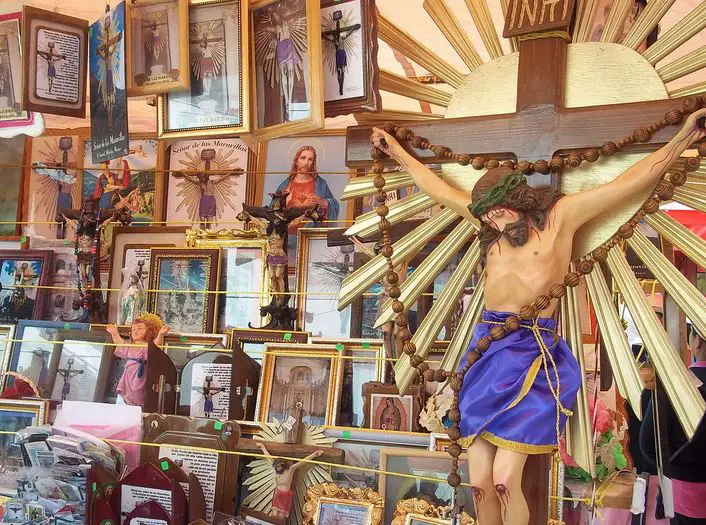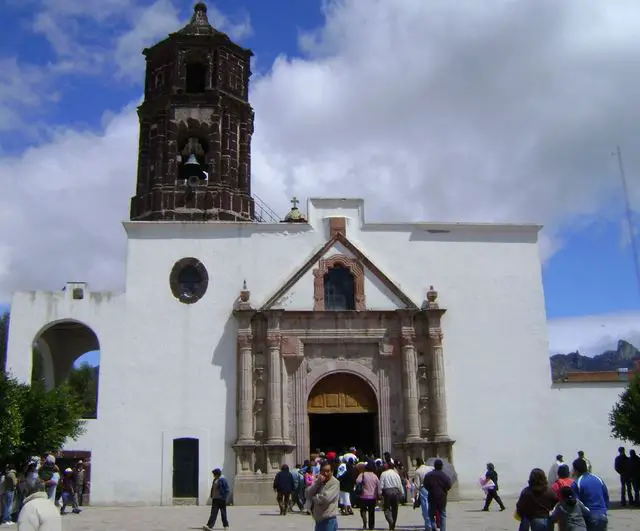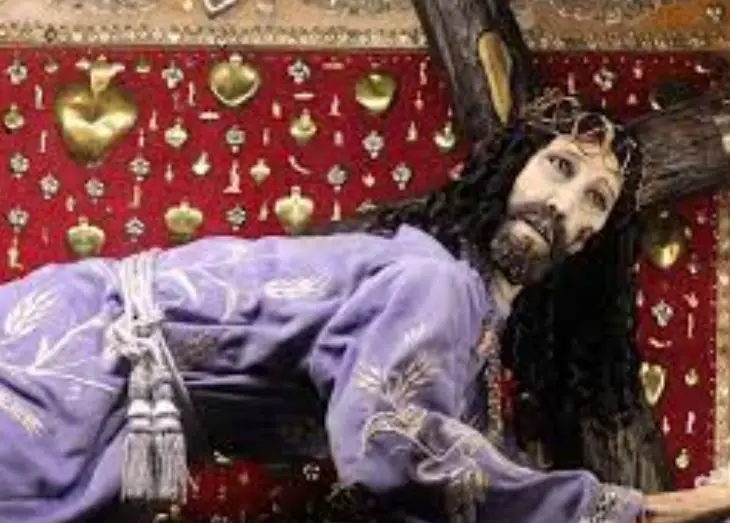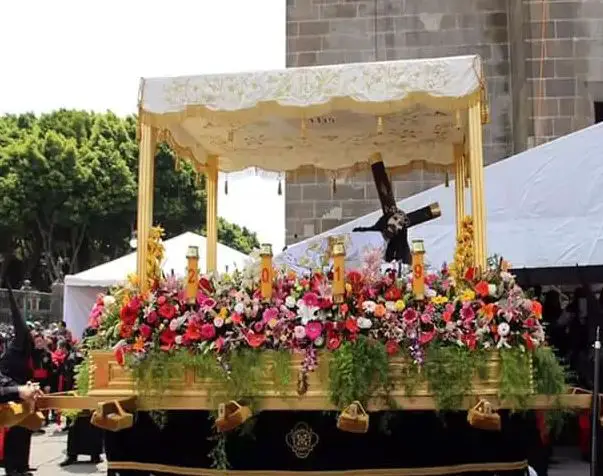Podcast: Play in new window | Download
Subscribe: Apple Podcasts | RSS
In Mexico there are many pilgrimage sites to many different virgins, saints and other apparitions and miraculous occurrences. Many of these devotions are not known outside Mexico or even outside their respective regions to other Mexicans. Many saints or virgins have multiple shrines set up to them. Nuestro Señor de las Maravillas, or Our Lord of Wonders, is one such devotion, having two major pilgrimage sites set up in the Mexican states of Hidalgo and Puebla, respectively.
Hidalgo
The origins of the image currently venerated in Hidalgo are unknown, and it is not known when it was made or who made it. Some say that the carved Christ came on a galleon from the Spanish Philippines, but this is just speculation. What is known is that in 1806 an old woman from Atotonilco el Chico in the state of Hidalgo arrived in the city of El Arenal carrying a sculpture of the crucified Christ. She called this cristo El Señor de los Laureles or “Our Lord of the Laurels” in order to sell it. After not finding a buyer, and given the poor financial situation of the woman, the  family of Don Andrés Pérez carried out a collection in the town and acquired the cristo for 30 pesos. Another version of the story maintains, however, that a group of pilgrims from Atotonilco was heading towards Actopan with the statue when, after arriving at El Arenal, it began to become so heavy that they decided to stop and rest, proceeding the next day to put the carving up for sale. The sculpture was purchased and put in a small hermitage, and then ended up at its current location, the Sanctuary of the Lord of Wonders built in 1812 right before Mexico became an independent country. Soon people began to allege that miracles were associated with the statue, which led to the decision to move it to the town of Actopan. Each time they tried to move the carving, a storm prevented it, so it was finally decided that El Arenal would be its permanent home. There is a popular legend that states that a wife cheated on her husband with another man while he was working in the fields, the woman having the habit of bringing a basket of food to her secret love when she committed adultery. Her husband, warned of his wife’s behavior, decided to keep an eye on her. After intercepting her one day while she was on her way to see her lover, the man asked his wife what was in her basket. The woman, aware of the violent character of her husband, entrusted herself to the Lord of Wonders and lied to her husband, saying that she brought items for the monks at the hermitage where the image of Christ was venerated. The man, believing that his wife was lying to him, threw the basket to the ground and instead of food, religious articles fell out, including devotional candles, communion wafers, sacramental wine, rosaries and saintly amulets. This story caused the image to acquire great fame and devotion and pilgrimages to the shrine increased.
family of Don Andrés Pérez carried out a collection in the town and acquired the cristo for 30 pesos. Another version of the story maintains, however, that a group of pilgrims from Atotonilco was heading towards Actopan with the statue when, after arriving at El Arenal, it began to become so heavy that they decided to stop and rest, proceeding the next day to put the carving up for sale. The sculpture was purchased and put in a small hermitage, and then ended up at its current location, the Sanctuary of the Lord of Wonders built in 1812 right before Mexico became an independent country. Soon people began to allege that miracles were associated with the statue, which led to the decision to move it to the town of Actopan. Each time they tried to move the carving, a storm prevented it, so it was finally decided that El Arenal would be its permanent home. There is a popular legend that states that a wife cheated on her husband with another man while he was working in the fields, the woman having the habit of bringing a basket of food to her secret love when she committed adultery. Her husband, warned of his wife’s behavior, decided to keep an eye on her. After intercepting her one day while she was on her way to see her lover, the man asked his wife what was in her basket. The woman, aware of the violent character of her husband, entrusted herself to the Lord of Wonders and lied to her husband, saying that she brought items for the monks at the hermitage where the image of Christ was venerated. The man, believing that his wife was lying to him, threw the basket to the ground and instead of food, religious articles fell out, including devotional candles, communion wafers, sacramental wine, rosaries and saintly amulets. This story caused the image to acquire great fame and devotion and pilgrimages to the shrine increased.
 So, what does this image look like? The statue is made of polychrome wood, has a straight-haired wig and beard, and shows Christ immediately after his death on the cross, with his head fallen to his right side and his body covered with various bleeding wounds. The one on the right side stands out the most. He is cloaked in real cloth, usually an unadorned lilac color, although sometimes he is dressed in a purple cloak with fringes and gold-colored embroidered details. On his head he wears a royal crown instead of the characteristic crown of thorns. Behind the cross several golden rays form the shape of an oval. This Señor de las Maravillas rests on a stone altarpiece and is encased in protective glass. On the fifth Friday of Lent, the feast of the Lord of Wonders is celebrated, which includes a religious procession, masses and pilgrimages. Also, the dance of the Concheros is performed. This dance has indigenous origins, and its original significance is unknown. The Lord of Wonders has a special prayer said to him, first thanking him for life and for providing the believer with a unique destiny on earth, following with a petition for forgiveness and usually a request.
So, what does this image look like? The statue is made of polychrome wood, has a straight-haired wig and beard, and shows Christ immediately after his death on the cross, with his head fallen to his right side and his body covered with various bleeding wounds. The one on the right side stands out the most. He is cloaked in real cloth, usually an unadorned lilac color, although sometimes he is dressed in a purple cloak with fringes and gold-colored embroidered details. On his head he wears a royal crown instead of the characteristic crown of thorns. Behind the cross several golden rays form the shape of an oval. This Señor de las Maravillas rests on a stone altarpiece and is encased in protective glass. On the fifth Friday of Lent, the feast of the Lord of Wonders is celebrated, which includes a religious procession, masses and pilgrimages. Also, the dance of the Concheros is performed. This dance has indigenous origins, and its original significance is unknown. The Lord of Wonders has a special prayer said to him, first thanking him for life and for providing the believer with a unique destiny on earth, following with a petition for forgiveness and usually a request.
Puebla
The shrine to the Señor de las Maravillas in the city of Puebla is somewhat different from the one in El Arenal, Hidalgo. The building was initially a shelter for Spanish wives, then an orphanage for girls and later converted into the Convent of Santa Monica. It was built in the year 1606 and underwent renovations in the 18th century, the second half of the 19th and the beginning of the 20th. In 1934 the Augustinian nuns who inhabited it were secularized by virtue of Mexico’s Reform Laws. In the following year the building became a museum and in 1940 it fell under the administration of the National Institute of Anthropology and History.
 There is a legend about the creation and veneration of the image of the Lord of Wonders as found in Puebla: Centuries ago, outside the Templo de San José, located somewhere in the historic center of the city, a leafy tree once stood until one day lightning struck it down. The parish priest of the church of San José ordered an artisan to carve the image of Christ out of the wood from the tree. The image was to be of Christ in one of the falls of the Via Crucis. The skillful hands of the artisan produced an image that represented great piety and compassion. The image was originally called Nuestro Señor de los Rayos or Our Lord of Lightning. Later, this cristo was obtained by the Augustinian nuns in a raffle, who took it to their convent, which is now the current location of the shrine. Originally, the carving was accompanied by two Roman soldiers who held whips. In the convent, it is said that a novice heard groans and whip noises one night. In the company of the mother superior, she discovered that the Jesus statue was actually being whipped. The news of this event spread everywhere and in this way the image acquired fame and devotion. Sometime later, the carved Roman executioners were withdrawn and burned. There is another popular legend connected with this cristo which is like the one told in Hidalgo. A woman went every day to visit her husband, confined in the San Juan de Dios prison across the street from the Convent of Santa Monica. During her visits, she noticed the presence of a poor inmate whom no one would ever see, so the woman, moved, decided to secretly visit that man every time she went to see her husband. When her husband was released, the woman continued to go to the jail to visit the man, always bringing him a basket full of food. Her husband, alerted to the activities of his wife and suspecting that she was unfaithful to him, decided to wait for her one day at the gates of the prison. After intercepting her, he asked his wife what was in her basket, to which she replied that she was carrying only religious items. The man, suspicious, uncovered the basket and found exactly what his wife said would be in there: devotional candles, communion wafers, sacramental wine, rosaries and saintly amulets. In some versions of the story, when the husband uncovers the basket, it starts pouring out roses, much like what happened to San Juan Diego when he unfurled his cloak to reveal the image of the Virgin of Guadalupe. The woman, herself surprised, entered the grounds of the convent with her husband, where she confessed the truth. Both went immediately to the prison in order to see the inmate, although they could not find him or obtain any news about him, so they assumed that this man was Christ, who had put the couple’s love to the test. This story caused the carving, initially known as Lord of Lightning to come to be called the Lord of Wonders.
There is a legend about the creation and veneration of the image of the Lord of Wonders as found in Puebla: Centuries ago, outside the Templo de San José, located somewhere in the historic center of the city, a leafy tree once stood until one day lightning struck it down. The parish priest of the church of San José ordered an artisan to carve the image of Christ out of the wood from the tree. The image was to be of Christ in one of the falls of the Via Crucis. The skillful hands of the artisan produced an image that represented great piety and compassion. The image was originally called Nuestro Señor de los Rayos or Our Lord of Lightning. Later, this cristo was obtained by the Augustinian nuns in a raffle, who took it to their convent, which is now the current location of the shrine. Originally, the carving was accompanied by two Roman soldiers who held whips. In the convent, it is said that a novice heard groans and whip noises one night. In the company of the mother superior, she discovered that the Jesus statue was actually being whipped. The news of this event spread everywhere and in this way the image acquired fame and devotion. Sometime later, the carved Roman executioners were withdrawn and burned. There is another popular legend connected with this cristo which is like the one told in Hidalgo. A woman went every day to visit her husband, confined in the San Juan de Dios prison across the street from the Convent of Santa Monica. During her visits, she noticed the presence of a poor inmate whom no one would ever see, so the woman, moved, decided to secretly visit that man every time she went to see her husband. When her husband was released, the woman continued to go to the jail to visit the man, always bringing him a basket full of food. Her husband, alerted to the activities of his wife and suspecting that she was unfaithful to him, decided to wait for her one day at the gates of the prison. After intercepting her, he asked his wife what was in her basket, to which she replied that she was carrying only religious items. The man, suspicious, uncovered the basket and found exactly what his wife said would be in there: devotional candles, communion wafers, sacramental wine, rosaries and saintly amulets. In some versions of the story, when the husband uncovers the basket, it starts pouring out roses, much like what happened to San Juan Diego when he unfurled his cloak to reveal the image of the Virgin of Guadalupe. The woman, herself surprised, entered the grounds of the convent with her husband, where she confessed the truth. Both went immediately to the prison in order to see the inmate, although they could not find him or obtain any news about him, so they assumed that this man was Christ, who had put the couple’s love to the test. This story caused the carving, initially known as Lord of Lightning to come to be called the Lord of Wonders.
 How does the image in Puebla differ from the one in Hidalgo? The Puebla cristo is dressed finely and dons a wig made up of ringlets. It shows Christ fallen on the ground with the cross on his left side, resting on his knees and arms, his head turned to his right with a bleeding wound on his left cheek. The carving is life-size and weighs about 145 pounds. It is housed next to the choir gate inside the shrine. The image is often decorated with metal heart milagros, most of them made of gold or silver, given as gifts by the faithful. Next to the statue is a place for candles which was apparently the cause of a fire that occurred in the shrine on January 1, 2013. Miraculously, the image was unharmed. The Puebla version of the Señor de las Maravillas has three annual festivals: July 1, Good Friday and the third Friday of Lent. On the festival of July 1, it is a tradition that a mariachi performs “Las Mañanitas” at the entrance of the shrine where it is common for there to be food tasting. On Good Friday the image is removed from the shrine and becomes part of a procession along with other images of the area, such as the Virgen de los Dolores, Jesús de Analco, Jesús Nazareno and the Virgen de la Soledad. One of the most famous rituals related to the Lord of Wonders is the limpia, consisting of approaching the image with a yellow candle, making the sign of the cross and then proceeding to “clean” the whole body or a part with the same candle, which is later lit and deposited, either next to the image, or in the private home. The limpia is often performed by a trained practitioner for a fee. Also on the festival days, the nuns sell bagged fragments of cloth from garments that used to adorn the cristo, as devotees believe the cloth has special curative powers. The shrine in Puebla has more visitors from a larger geographical area, and the one in Hidalgo is seen as a humbler place to honor this interesting depiction of Christ.
How does the image in Puebla differ from the one in Hidalgo? The Puebla cristo is dressed finely and dons a wig made up of ringlets. It shows Christ fallen on the ground with the cross on his left side, resting on his knees and arms, his head turned to his right with a bleeding wound on his left cheek. The carving is life-size and weighs about 145 pounds. It is housed next to the choir gate inside the shrine. The image is often decorated with metal heart milagros, most of them made of gold or silver, given as gifts by the faithful. Next to the statue is a place for candles which was apparently the cause of a fire that occurred in the shrine on January 1, 2013. Miraculously, the image was unharmed. The Puebla version of the Señor de las Maravillas has three annual festivals: July 1, Good Friday and the third Friday of Lent. On the festival of July 1, it is a tradition that a mariachi performs “Las Mañanitas” at the entrance of the shrine where it is common for there to be food tasting. On Good Friday the image is removed from the shrine and becomes part of a procession along with other images of the area, such as the Virgen de los Dolores, Jesús de Analco, Jesús Nazareno and the Virgen de la Soledad. One of the most famous rituals related to the Lord of Wonders is the limpia, consisting of approaching the image with a yellow candle, making the sign of the cross and then proceeding to “clean” the whole body or a part with the same candle, which is later lit and deposited, either next to the image, or in the private home. The limpia is often performed by a trained practitioner for a fee. Also on the festival days, the nuns sell bagged fragments of cloth from garments that used to adorn the cristo, as devotees believe the cloth has special curative powers. The shrine in Puebla has more visitors from a larger geographical area, and the one in Hidalgo is seen as a humbler place to honor this interesting depiction of Christ.
